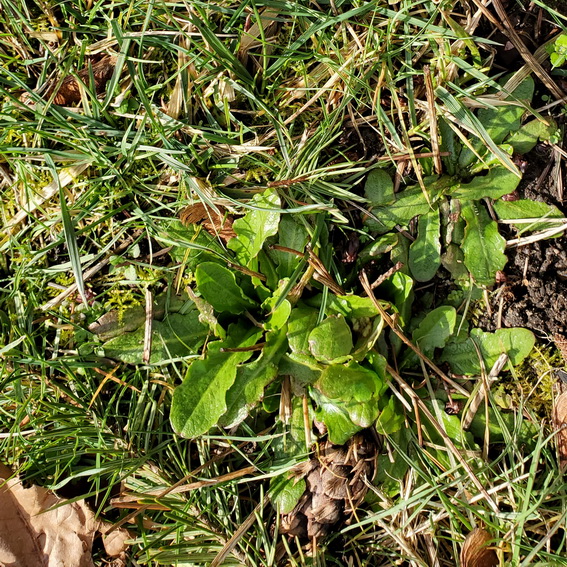Weeds of the Turf Next to Our Backyard Forests
Our backyard forests often lie next to areas of turf that receive no irrigation or chemical inputs and inconsistent mowing. These “input-free” turf areas provide ample opportunity for colonization by a host of plants that are not welcome in the forest. The main line of defense against the spread of these weeds are the Bradley Lines between the turf and the forest edge, but in the long run, it can save time and energy to do some selective hand weeding in the first few yards of turf.
Red Dead-Nettle, Shotweed, Self-Heal, and Chickweed
I don’t think it’s necessary or even desirable to try to remove all the weeds from the input-free turf. For Red Dead-Nettle, Shotweed, Self-Heal, and Chickweed, the annual maintenance of Bradley Lines is usually sufficient control. Arguably, letting these weeds grow in the turf provides an important ecological service by enriching the soil and acting as a nursery for some native plants.

Catsear, Broadleaf Dock, Curly Dock, Dandelion, and Plantain
Late in the dry season when the grass has turned brown and stopped growing, deeply-rooted perennial weeds stay green and continue to produce flowers. Though I don’t want any of these plants spreading into the forest, it’s only Catsear and Dock (Broadleaf and Curly) that I consistently remove from turf near the forest with a quick pry-and-pop and wiggle-and-pull. For me, the dandelions and plantains have some redeeming qualities, and I usually don’t worry about them in backyard turf.

English Daisy, Self Heal, Dovefoot Geranium, and Sheep Sorrel
English Daisy, Self Heal, Dovefoot Geranium, and Sheep Sorrel grow low to the ground and mowing does not prevent them from flowering and going to seed. For this reason, I sometimes remove them from the first few feet of turf outside the Bradley Line.
Non-Native Grasses
I assume that any grasses of input-free turf are non-native. With regular mowing, most can be prevented from going to seed, but I only try to remove visibly coarse clumps of grass because of the possibility they could be Reed Canarygrass.
The Input-Free Turf as a Nursery for Native Plants
Some native plants like Large-Leaved Avens, Fringecup, and Lady Fern also colonize input-free turf. When I spot them during the wet season it takes but a minute to “rescue them” and transplant them to a bare spot inside the Bradley Line.
